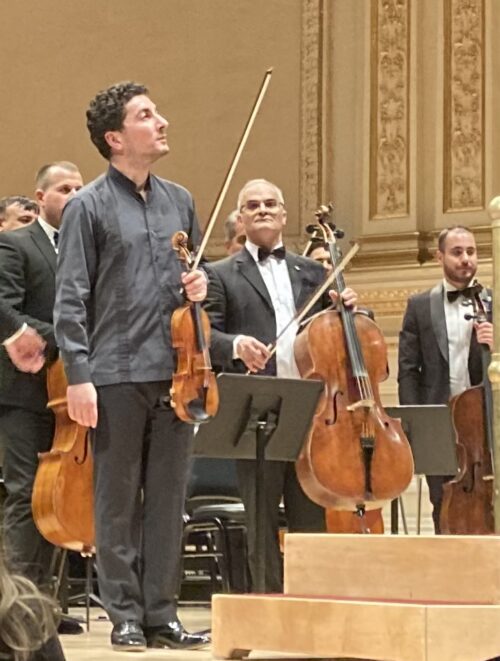
Why – I ask myself – was I so drawn to the Armenian National Philharmonic Orchestra at Carnegie Hall on Wednesday (Nov. 15)? Tangible reasons include the presence of violinist Sergey Khachatryan – one of the best out there – as well as the commercial recordings that have fitfully emerged from that mountainous former-Soviet country. Then there’s the Komitas factor. He was an Armenian priest, musicologist, composer and singer (1869-1935) whose recorded voice I discovered at The Record Shop in Red Hook, Brooklyn: While I was transfixed by the depth of his intensity, the store was in danger of being evacuated because others couldn’t take it,
At Carnegie, I was looking for great orchestral music played from an alternative tradition. Indeed, I found it – but the alternative not what I expected. The program by the Armenian National Philharmonic Orchestra (established 1925 and based in Yerevan) represented Armenia’s best-known composer Aram Khachaturian with excerpts from the ballet Spartacus and his Violin Concerto in the first half, and then, in what became a litmus test for the orchestra’s personality, the Rachmaninoff Symphony No. 2, conducted by longtime music director Eduard Topchjan. The New York appearance felt a bit under the grid. Though the orchestra is on a world tour that includes Montreal and Toronto, the concert was not a Carnegie Hall presentation, but arrived courtesy of something called Classic Music TV. The top two balconies weren’t available for sale. The audience looked like some sort of date night – lots of young-ish couples – and listeners wearing clothes with the kinds of design features you don’t see in the U.S. Unruliness was to be expected. Applause erupted between movements. Cracking down on phone cameras kept the Carnegie ushers very busy. But once the music started, silence set in and attention was complete.
The Khachaturian first half showed that the orchestra was well above provincial status, and would be a worthy edition to Carnegie Hall’s presentations of great orchestras from around the world. Every section had its own kind of homogenous, slightly-restrained smoothness that immediately drew in my ears. Not until the Rachmaninoff symphony did I realize that the strings were using a middling level of vibrato – not so little as to suggest a Roger Norrington performance, but enough that the sonorities seemed to glow from within, as opposed to bristling with surface excitement (as in high-vibrato performances). Much drama was generated by the contrasting sonorities of the different orchestral sections. Dimensions of sound opened up in the Rachmaninoff that immediately began to reveal the inner workings of the music but without the slightest sense that the symphony was being dissected. Anybody who loves this work knows how thematically integrated it is. But this performance particularly revealed such details, suggesting that underneath the lush sonorities is music that is downright rigorous. Incidental solos by English horn and clarinet delivered sounds that were particularly arresting, if only because they were not preceded by and engulfed in the usual thick orchestral sonority. Overall, nothing here seemed forced, and that included the Khachaturian Violin Concerto. Violinist Khachatryan has often struck me as a depressive stage presence when, as it turns out here, he was actually relaxed and releasing the music without any extraneous effort. Tension was not conveyed by magnitude of sound but the concentration of sound. Intensity didn’t come from playing harder but from inner intention. What I can’t explain is the deep wells of sound that periodically came forward from the orchestra in moments where the music truly called for it.
This was not hard-sell music making. And it was only by hearing this concert that I realized how much other recent performances this season oversold what was played. At the New York Philharmonic in recent weeks, Jaap van Zweden conducted the loudest Copland Symphony No. 3 that anyone could remember, bleaching out a good 60 percent of the music details, leaving only a general outline filled out by a wall of sound. Pictures at an Exhibition conducted by Susanna Mälkki showed the difference between loudness and grandeur, the former quality being much in evidence and the latter quality being almost completely absent. And these performances were rewarded with roaring ovations. The Philharmonic players know better and often play as though they do. But the loud performances are what we remember for better and for worse.
Of course, the Armenian orchestra played its own nationalistic music with authority. But flourishes suggesting, say, Arabic microtones, the sort that would be played by non-Armenian orchestra as touches of exoticism sounded perfectly natural here. So it is too in the orchestra’s new BIS-label recording Armenian Cello Concertos whose works by Babajanian, Petrossian and, of course, Khachaturian often have more a folk-based flavor, but never sound like postcard music. One has to ask: Can this orchestra also play Mozart? Sure, and does so as if speaking the music like a first language. The Armenian National Philharmonic Orchestra is all over YouTube in all kinds of repertoire, playing in an charmingly idiosyncratic round hall. Part of the season is full concert performances of opera, including the upcoming Tchaikovsky Queen of Spades. With the linguistic authority of singers trained close to Russia and the ‘inside-story’ approach to Tchaikovsky’s rich orchestral writing, I’ll be checking YouTube frequently for that one.


The Armenian National Philharmonic also looks to have toured to Boston:
https://www.classical-scene.com/2023/11/25/armenian-people/
Yes…it appears to have been a strangely low-key tour. I also understand that Air France gave the players tough time on the way home. DPS